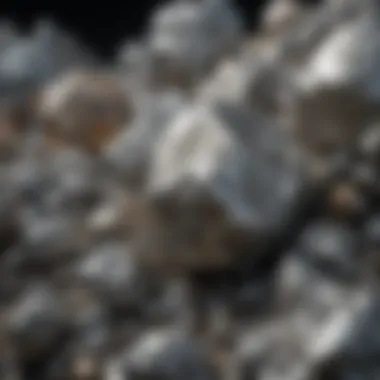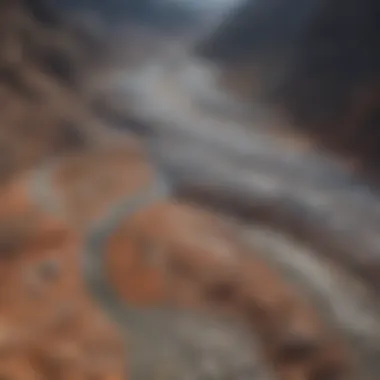Identifying Silver Ore: A Guide for Collectors


Intro
The quest for silver ore interest people regardless of their experience. Silver has long fascinated enthusiasts not just due to its value but also its historical significance and varied uses. In the world of geology and collecting, understanding how to identify silver ore can be the key to unearthing valuable specimens.
This guide is tailored for those who are keen to explore the nuances of silver ore identification, offering insights into its characteristics, potential locations, and methods for testing. Whether you’re just starting or have been at it for years, the information presented here is designed to enhance your knowledge and skills in this captivating pursuit.
Rock and Fossil Identification
Recognizing the distinctive traits of silver ore can make all the difference in your collecting endeavors. Here, we’ll break down how to effectively identify silver ore and related rocks.
Types of Rocks and Characteristics to Look For
When hunting for silver ore, understanding the types of rocks often associated with it is crucial. Typically, silver is found in conjunction with various sulfide minerals, like galena or pyrite, but can also occur in native forms. Key characteristics to observe include:
- Color: Silver ore can range from metallic gray to bright silver.
- Luster: A shiny, reflective surface is often a sign of silver.
- Texture: Look for a fine-grained structure or a more granular appearance
- Weight: Silver ore usually feels heavier than common rock.
Tools for Identification
Equipping yourself with the right tools can vastly simplify the identification process. Consider having these on hand:
- Hand lens: Helps magnify details for a closer look.
- Field notebook: Records observations and findings.
- Metal detectors: Great for finding buried ore.
Collecting Tips and Techniques
Once you’ve developed an eye for identifying silver ore, the next step is collection. Remember, it’s not just about finding it; it’s about how you collect it.
Best Practices for Collecting
- Respect regulations: Familiarize yourself with local laws regarding rockhounding.
- Leave no trace: Preserve the natural environment.
- Visual inspection: Before picking up, assess the area thoroughly.
Locating Prime Collecting Sites
Some areas are renowned for silver-hunting opportunities. These include:
- Old mining towns, rich in history.
- Mountain ranges, often exposing valuable minerals.
- Abandoned mines, where operations once thrived.
How to Safely Extract Specimens
Safety is paramount when collecting. Here are a few pointers:
- Wear gloves: Protect your hands from sharp edges and chemicals.
- Use proper tools: A small pick or hammer can help without causing damage.
- Be mindful of your surroundings: Keep an eye out for unstable terrain.
Preservation and Display
Once you have collected your treasured ore, you might wonder how to care for and display them.
Techniques for Preserving Rocks and Fossils
- Keep specimens dry and clean to prevent deterioration.
- Use wax or sealants for added protection.
Proper Storage Methods
Store your collection in a climate-controlled environment to prevent damage:
- Use display cases: Glass cases can highlight your finds.
- Label each specimen: Include details like the location and date found.
Creative Display Ideas
Think outside the box for displaying your collection:
- Use mounted frames to showcase beautiful pieces.
- Create themed sections based on location or type.
Geological Insights
Understanding the geology behind silver ores can enhance your collecting experience. Knowing how silver deposits form adds an enriching context to your finds.
Geological Formations and Processes
Silver is often deposited through hydrothermal processes, where magma heats water underground, dissolving minerals and carrying them to cooler areas where they crystallize. This can yield valuable ore veins.
Historical Significance of Rocks and Fossils
The discovery of silver ores has shaped economies and histories. Think of the silver rush in the American West—people flocked to areas like Nevada, hoping to strike it rich.
Notable Discoveries in the Field
Some classic finds making headlines include:
- The Comstock Lode in Nevada, producing massive quantities of silver.
- The Silver Valley in Idaho, another hotspot for collectors.
"Understanding the historical significance can deepen appreciation for each piece collected."


In your journey of identifying and collecting silver ore, these insights will equip you with the knowledge to make informed decisions. The further you delve into the intricacies of geology, the more rewarding your collecting experiences will become.
Prelude to Silver Ore
When it comes to identifying silver ore, understanding the foundations of this precious metal is crucial. Silver has long been recognized not just for its beauty, but for its economic significance. This section sets the stage by highlighting why silver is essential to collectors and enthusiasts alike. Silver ore itself is a testament to both geological processes and human history, offering valuable insight into mining practices and the allure of precious metals.
Understanding Silver as a Commodity
Silver is much more than a shiny metal; it plays a pivotal role in various industries. From electronics to photography, its properties make it a sought-after material. This metal has held a special place in the economy, serving as a currency, a measure of wealth, and now, as an essential component in modern technology.
However, the fluctuating market values add a layer of complexity. As silver prices rise and fall, the interest in identifying silver ore increases. Understanding these market forces can help collectors gauge the potential value of their finds.
The physical characteristics of silver itself—gleaming appearance, malleability—make it distinguishable from other minerals, yet there are grades and qualities that differentiate high-quality ore from that which may hold little value. Being savvy about the nuances of silver can steer collectors toward informed purchasing and mining decisions.
Historical Context of Silver Mining
To appreciate silver ore fully, it’s important to consider its historical context. Silver mining has roots that stretch back thousands of years. Civilizations like the Ancient Egyptians and Romans prized silver, using it for coinage and artifacts. As a result, mining techniques evolved dramatically.
Many of today’s mining regions have been hubs of silver extraction for centuries. For instance, places like Potosí in Bolivia have a storied past. As silver boomtowns emerged, entire cultures revolved around the mining economy. Understanding the history of silver mining not only enriches the collector's perspective but also connects them to a long line of enthusiasts who have sought this rare commodity before them.
"Silver mining didn't just shape landscapes; it folded societies and economies around it, influencing trade routes that Date back to antiquity."
By diving into these layers of history, modern collectors can develop a deeper appreciation for their pursuits. Each piece of silver ore carries with it echoes of past endeavors, struggles, and triumphs.
Geological Formation of Silver Ore
Understanding the geological formation of silver ore is pivotal for any collector or geologist delving into the world of silver mining. The formation of silver deposits informs enthusiasts not only about where to find these precious minerals but also about their origins and characteristics. This section breaks down the types of silver ore and sheds light on the formation conditions, all crucial in the quest to identify silver in its various forms.
Types of Silver Ores
Native Silver
Native silver is often a collector's dream, offering a glimpse into raw, unrefined beauty. This form of silver occurs naturally, typically appearing as silver leaves, wires, or crystals in the earth. One key characteristic that sets native silver apart is its distinctive metallic luster, which can be easily spotted by a trained eye. It tends to be a popular choice among collectors, both for its aesthetic appeal and its historical significance.
However, native silver can also pose challenges. Due to its relative rarity, obtaining it can be tough without navigating complex mining regulations or having the right connections. Additionally, its tenacity to be susceptible to tarnishing can be a drawback for some collectors who prefer low-maintenance pieces.
Argentite
Argentite, or silver sulfide, is another notable player in the world of silver ores. This compound is characterized by its dark, metallic sheen and is often found in the same regions as native silver. Argentite is crucial for extracting silver due to its relatively high silver content; it’s often processed in refineries to yield pure silver. Its importance cannot be understated: argentite is a beneficial choice in the smelting process and thus has a significant role in the economics of silver mining.
Yet, argentite has its own set of quirks. For one, its softer nature compared to native silver can make it more vulnerable to wear over time. Although it’s not as visually appealing, its contribution to silver production makes it an essential item on any collector's radar.
Silver Sulfides
When discussing silver ores, one cannot overlook silver sulfides. These minerals, composed mainly of silver and sulfur, often come alongside other metallic ores, making them essential for geological studies. Silver sulfides can range in appearance, but they generally exhibit a dull luster, which contrasts sharply with the grandeur of native silver. Their significance stems from their abundance, making them a common find during prospecting.
Interestingly, silver sulfides can be both an advantage and a disadvantage for collectors. While their occurrence is frequent, it also means that true specimens of higher purity can be harder to come by amid the more common finds. Still, for the effective identification and understanding of silver ores, knowledge of silver sulfides is indispensable.
Location and Formation Conditions
The formation conditions under which these silver ores evolve are as varied as the ores themselves. Primarily, silver ores are formed in hydrothermal veins, where mineral-rich geothermal fluids interact with rocks. This geological process tends to create concentrations of silver in specific locations, often accompanied by lead, zinc, and sulfur. Enthusiasts should focus their search around known volcanic and tectonic regions or historic mining camps notorious for silver discoveries.
To wrap it up, geological formation plays a critical role in knowing where and what to focus on in the hunt for silver ore. Understanding the types of silver ores and their formed environments helps enthusiasts become sharper and more informed collectors. With this knowledge, the journey to identifying silver ore can be both enlightening and fruitful.
Physical Characteristics of Silver Ore
Understanding the physical characteristics of silver ore is critical for anyone interested in this fascinating pursuit. Identifying silver ore through its physical traits enables collectors to differentiate it from other minerals and, ultimately, increases their success in finding and valuing their specimens. An appreciation of these characteristics allows enthusiasts to make informed decisions and enhances their overall collecting experience.
Visual Identification Techniques
Color and Appearance
The color and appearance of silver ore are fundamental aspects that aid in identification. Typically, silver-bearing minerals display a metallic grey shade that can vary with the mineral composition. For instance, argentite often exhibits a darker hue compared to native silver, which shines brightly. The reflective quality of these ores may not only attract the eye but can also assist an enthusiast in spotting potential silver deposits.
A key characteristic is the ability of silver ore to tarnish, leading to shades ranging from dull grey to vivid black. This aspect is particularly beneficial for collectors as it helps distinguish between silver and similar-looking minerals, such as galena.
One unique feature of the color and appearance of silver ore is its response to the presence of other minerals. For example, ores often look strikingly different when they contain various impurities. This can either enhance or diminish the ore's beauty, impacting its market value, which should be considered during collection.
Texture and Luster
Texture and luster are equally important in identifying silver ore. The luster indicates how light interacts with the mineral surface. Silver ore typically possesses a metallic luster, providing a vital clue for identification. In this case, an enthusiast’s keen eye for detail can prove valuable.
Another critical aspect is the texture of the ore. Silver ores vary from smooth, reflective surfaces to rough, granular textures. This variability can impact a collector's approach, as ores with a smooth texture may appear more visually appealing.
While metallic luster is beneficial, the handling of specimens with rough textures may be more challenging. Care must be taken to avoid damaging the ore during collection or transport, which can affect its overall appearance and value.
Weight and Hardness Assessment
Weight and hardness are crucial measures in the identification process of silver ore. These elements enable one to gauge the mineral's density and resistance to scratching, which can help differentiate silver ore from other metallic ores that might look similar.
Specific Gravity Tests


Specific gravity tests measure how dense a mineral is compared to water. This method proves useful as silver ore generally has a notably high specific gravity, ranging around 10.5 g/cm³ for native silver.
This high density is a key factor that collectors can use. When comparing it to lighter ores, silver's heft becomes apparent, acting as a telltale sign in the identification process.
One drawback of relying solely on these tests is that they can sometimes require specialized equipment, which may not always be available to amateur enthusiasts. However, understanding this aspect is still critical for informed evaluation of found specimens.
Hardness Scale Comparison
The hardness scale comparison is another effective way to assess silver ores. Using the Mohs scale of mineral hardness, silver typically ranks between 2.5 and 3.5.
This means it can be scratched by harder minerals like quartz but can scratch softer ones like gypsum. Knowing the hardness of a mineral aids in distinguishing it from similar-looking materials. A collector familiar with this scale can quickly assess and identify possible silver ores in the field.
However, it is essential that collectors remain cautious about the limitations of this method. For instance, soft impurities within a mineral may skew results, leading to an erroneous identification.
"Understanding the physical characteristics of silver ore is like having a map to a treasure chest—each detail is a marker guiding you toward your prize."
Locating Silver Ore
Understanding how to locate silver ore is crucial for anyone interested in geology or mining. This aspect not only guides you on where to focus your efforts but also enhances your chances of successful collection. Knowing specific regions, geological formations, and indicators can make this journey less daunting.
Regions Rich in Silver Deposits
Notable Mining Areas
When we talk about notable mining areas, places like the Comstock Lode in Nevada come to mind. This area is famed for its rich deposits of silver that played a significant role in the economic boom of the American West. One key characteristic of this region is its history; it was one of the first major discoveries of silver in the United States, drawing thousands of miners and prospectors.
The Comstock Lode's unique feature is how the silver was found in veins of quartz-rich rock, which made it easier for miners to identify potential mining sites. The advantages of focusing on such historical areas are numerous. Not only do they have a proven track record, but their historical context can also lead to discovering valuable artifacts intertwined with silver mining history. However, they are often heavily regulated and may require permits, making it essential to stay informed about the legal conditions.
Geological Formations Associated with Silver
Delving into geological formations, we primarily consider areas like volcanic regions and sedimentary basins. Silver often occurs in hydrothermal veins, where heated mineral-rich fluids precipitate metals. These formations are a beneficial choice for enthusiasts as they tend to host various minerals alongside silver. The unique feature here is how geological changes over time can concentrate silver ores, creating enriched deposits that are a treasure for miners.
Yet, the intricacies of these formations can also present challenges. Identifying the right type of rock or formation requires experience, and there are risks involved, particularly in remote areas where geological disturbances may occur. Overall, understanding these formations provides a solid foundation for any collecting or mining endeavor.
Indicators of Silver Ore Presence
Surrounding Rock Types
Surrounding rock types play a pivotal role in identifying areas likely to contain silver. Typically, granite or volcanic rocks are significant indicators of silver deposits. For instance, regions with felsic rock types, known for containing quartz and feldspar, often align with silver ore presence. This characteristic is a boon for anyone studying these environments as it narrows down the search area.
The unique feature about surrounding rock types is how they can tell a story of the geological past, indicating where silver may have leached into the formations. However, variations in geology can complicate this; not every granite area will yield silver. Learning to differentiate rock types could lead to significant rewards but requires keen observation and some experience.
Mineral Associations
Mineral associations are critical when identifying silver ore. Silver is often found alongside other minerals, such as lead, zinc, and copper. This characteristic makes it a popular choice for miners because identifying these mineral associations can enhance the chances of finding silver. For example, galena, which is lead sulfide, frequently contains silver in small percentages, signifying that areas with galena have high potential for silver finds.
The unique feature of mineral associations is their interrelationship; knowing the presence of one can hint at others nearby. But pitfalls exist; relying solely on one mineral association can lead to missed opportunities if other valuable ores are present in the same area. A more holistic view of the mineral spectrum in the area may serve collectors well.
"Paying attention to both geological and mineralogical clues can dramatically improve your chances of locating silver ore."
Testing for Silver Content
Testing for silver content is a crucial step for both the hobbyist and professional alike. This process helps determine the actual presence and quantity of silver within a sample, so a knowledgeable collector can make informed decisions about the potential value of their finds. Through chemical and physical testing methods, one can confirm the suspicions raised during the initial visual assessments of rock samples. This section details the various testing techniques available, each with its own merits and drawbacks.
Chemical Testing Methods
Chemical testing involves using specific reactions to ascertain the presence of silver in an ore sample. While this method can be quite effective, safety is paramount, given the use of hazardous substances.
Aqua Regia Test
The Aqua Regia Test stands out for its ability to dissolve metals, including silver. This powerful acid solution, made by mixing hydrochloric and nitric acids, can analyze multiple types of ore in a single go. One key characteristic of this test is its strength—it's one of the few processes that can dissolve even inert metals.
The primary reason this method is considered a beneficial choice is its versatility. It not only detects silver but also other precious metals like gold and platinum. The unique feature of Aqua Regia is its capacity to react vigorously with various minerals, leaving the user with a definitive assessment of silver's presence. However, it must be noted that the process can be dangerous due to the toxic fumes emitted and requires careful handling to avoid accidents.
Cyanide Test
The Cyanide Test specifically reacts with silver in some ores, helping to confirm its existence. This method is notable for its effectiveness and speed. One of its key characteristics is that it typically gives a quicker readout than some other methods, making it popular among collectors who appreciate expedience.
A unique feature of the Cyanide Test is the preferential reaction it can have with silver over other metals, which is advantageous when analyzing mixed-ore samples. That said, caution is imperative because of the high toxicity of cyanide; proper safety measures are a must when conducting this test.
Physical Testing and Assays
Physical testing and assays provide alternative approaches to determining silver content with generally less risk involved. They can be just as conclusive as chemical methods, often requiring equipment that may be found in a traditional laboratory or even at home for the dedicated enthusiast.
Flame Test
The Flame Test is a relatively straightforward method relying on the color produced when igniting a small sample of the ore. This method is useful primarily because it requires minimal equipment—usually just a Bunsen burner and a non-flammable surface, although having a spectroscope can enhance results. A key characteristic of the Flame Test is its simplicity. Depending on the color produced when heated, a general identification of minerals could be possible.
While this test isn't specific to silver alone, it can highlight the presence of associated minerals that might indicate silver's presence within the rock. This can be advantageous, as the operation is quick and allows for field testing. However, it does require a certain level of experience to interpret the color results correctly.
Lead Fire Assay


Lead Fire Assay is often regarded as one of the most reliable testing methods for quantifying metal content, including silver. This method is characterized by its accuracy—considered the gold standard in metal assays—yielding extremely precise measurements. The process involves melting the sample in a furnace, where lead absorbs the silver, followed by extraction and weighing for a final analysis.
The unique feature of Lead Fire Assay lies in its historical significance; it's been used for centuries to determine metal contents in ores. An advantage of this method is that it can measure the silver content with high precision, making it a favored choice among professionals. The disadvantage, however, includes the required complexity, infrastructure, and costliness of the process, which can be a barrier for some collectors.
Legal Considerations in Collecting
When diving into the world of silver ore collection, it's crucial to be aware of the legal considerations that come into play. The thrill of discovering silver ore can sometimes cloud judgment when it comes to understanding the laws surrounding mining and collecting. Ignoring these regulations can lead to serious consequences, including fines or even legal action. Therefore, grasping the laws is an essential step for any enthusiastic collector.
Understanding Mining Laws
Mining laws can be a bit like navigating a maze—they can vary widely depending on the country, state, or local jurisdiction you're in. In some places, what may seem like a harmless hobby could actually be subject to strict regulations, particularly on land ownership and mineral rights. One key point to remember is that many areas require permission from landowners or governmental bodies before any digging or collection can take place.
For instance, in the United States, the General Mining Law of 1872 grants U.S. citizens the right to mine for minerals on federal lands with few restrictions. However, this law has gone through many amendments and debates over the years; thus, understanding current local regulations is vital. Similarly, other countries may have stringent mining laws that prioritize environmental protection and indigenous rights. Hence, before you pick up your pickaxe, it’s best to ensure you’re not trespassing or violating any laws.
Permits and Permissions
In many cases, collectors will need to obtain permits or permissions, especially if they plan to conduct extensive digging. Obtaining these permits can be a defining moment in your collecting journey. Here are a few important steps and considerations:
- Research Local Regulations: Local government websites are treasure troves of information. Learn about the specific requirements in your area.
- Contact Relevant Authorities: Agencies such as the Bureau of Land Management or local environmental protection offices can provide clarity on what is required. Don't hesitate to reach out and ask questions.
- Landowner Agreements: If you plan to collect on private property, getting explicit permission from the landowner is not just courteous—it’s legally required. A written agreement can provide a safeguard for both parties.
- Application Process: Sometimes you'll need to fill out an application form, which might involve a small fee. Understand the timeline for approval so you’re not left waiting when opportunities arise.
- Respect Regulations: Once you have the permits, it’s essential to adhere to the specific conditions laid out. This may include restrictions on the methods you can use or keeping certain environmental standards.
Remember, navigating through the legal landscape may seem daunting, but adhering to these regulations not only cultivates a responsible collecting habit but also paves the way for future enthusiasts to enjoy the same joy of discovery without infringing on laws.
"A mindful collector is a responsible collector. Understanding the legal framework fosters respect and integrity in the geology community."
Being informed saves you time and effort in the long run, allowing you to focus more on what you enjoy most—discovering and collecting silver ore while standing on the right side of the law.
Preservation and Storage of Silver Ore
Preserving and storing silver ore properly is crucial for collectors and enthusiasts alike. The right preservation techniques not only protect the material from damage but also help in maintaining its value over time. Improper storage conditions can lead to tarnishing or deterioration, thus diminishing the appeal and potential monetary value of the ore. This section discusses methods to ensure your silver ore remains in the best condition possible, emphasizing importance of humidity control, container types, and effective cleaning techniques.
Best Practices for Storing Silver Ore
Humidity Control
Humidity is a critical factor when it comes to storing silver ore. Too much moisture in the air can lead to oxidation, resulting in tarnishing and degradation of the ore's surface. Controlling humidity is essential to ensure that silver ore retains its luster and quality. A common recommendation is to maintain indoor humidity levels between 30% and 50%.
A unique feature of humidity control systems, like dehumidifiers, is that they not only reduce moisture but often come with humidity indicators. This allows collectors to monitor and adjust the environment as needed. On the downside, if one does not pay attention to pricing or running costs, maintaining a controlled environment may become a financially straining responsibility.
Container Types
The type of container used for storing silver ore has a significant impact on its preservation. Using airtight containers, such as glass jars with rubber seals or specialized plastic cases, minimizes exposure to air and moisture. Keeping your silver ore in containers made from non-reactive materials is one of the best choices for protecting it. The absence of metal materials ensures there is no risk of chemical reactions causing further degradation.
A unique aspect of these containers is their ability to be portable. Many collectors appreciate lightweight, sturdy storage that allows safe transport of their collection. However, it is essential to choose containers with adequate cushioning for impact protection, as careless handling could lead to scratches or chips in the ore itself.
Cleaning and Care Techniques
Handling with Care
Handling silver ore properly is fundamental to its longevity. This mineral can be delicate, and any rough handling may scratch or otherwise damage the surface. Gentle handling techniques, including the use of clean cotton gloves, minimize the transfer of oils and dirt from your hands which can cause tarnishing.
An important aspect of careful handling is the awareness of weight distribution. Avoiding sudden movements and ensuring that one supports the ore adequately can prevent accidents. Still, extra precautions do come with their downsides, as some collectors may find it cumbersome to always be cautious about how they touch or transport their pieces.
Safe Cleaning Methods
When it comes to cleaning silver ore, using safe methods is critical to preserving its natural beauty. Ideally, one should avoid harsh chemicals or abrasives. Instead, a mild soap solution with warm water can work wonders. Gently brushing the surface with a soft brush helps to dislodge dirt particles without scratching the ore.
The appealing aspect of safe cleaning methods is they are often very accessible; common household items can serve the purpose well. However, one should be cautious of overcleaning, as frequent scrubbing can accumulate wear over time. Regular but minimal cleaning is advisable to maintain the ore without risking it.
Proper preservation and storage of silver ore not only enhances its value but also enriches the collector's experience, ensuring that every piece can be appreciated for a long time.
By adhering to recommended practices in humidity control, choosing appropriate containers, and employing careful handling and cleaning methods, enthusiasts can maintain the integrity and allure of their silver ore collections.
Closure
Summing up the journey through the intricate world of silver ore identification, it's clear that gaining familiarity with the techniques outlined is crucial for any collector. This article doesn't just scratch the surface; it dives deep into the substance and diversity of silver ores. Each technique for identifying these ores is not just an academic exercise—it’s a valuable skill that can significantly elevate one's collection and understanding of geology.
The benefits of mastering these identification techniques are manifold. First and foremost, it empowers collectors to make informed choices. Whether you're sifting through a dusty old box at a flea market or scratching beneath the surface of a promising claim, knowing what to look for can lead to winning discoveries.
"The thrill of finding real silver ore can rival any treasure hunt; it’s about understanding what lies beneath the rocks."
Moreover, there are practical considerations to keep in mind. A more informed approach can also lead to safer collecting practices and help avoid any legal grey areas that often accompany mining and collection activities. With knowledge comes responsibility. Collectors who are well-versed in legalities and preservation techniques can ensure that their endeavors do not infringe on laws or harm the environment.
In essence, this guide serves as both a starting point and a reference for enthusiasts at any level. Continuous learning about the nuances of ore identification can only enrich the experience, allowing for a deeper appreciation of the mineral kingdom.
Recap of Key Identification Techniques
- Visual Identification: Recognizing native silver, argentite, and silver sulfides based on their distinct colors, textures, and luster.
- Physical Assessment: Utilizing specific gravity and hardness assessments to gauge ore properties.
- Testing for Silver Content: Engaging in chemical testing methods, such as the Aqua Regia test, which can confirm the presence of silver.
- Legal Considerations: Staying informed about local mining laws and acquiring necessary permits before engaging in collection.
Collectively, these methods act as tools in a collector's arsenal, enhancing their chances of not just identifying, but also appreciating the rich tapestry of geology intertwined with silver ore.
Encouragement to Explore Further
If this article has sparked curiosity, it’s worth taking that next step down the rabbit hole of silver ore exploration. The world of geology is vast, and silver is just one piece of the puzzle. There are countless resources—books, online forums, and even local clubs—where knowledge flows freely.
Consider joining online communities like reddit.com where members share insights and experiences regarding ore collection. You might stumble upon hidden gems (not of the precious kind, but knowledge-wise) shared by fellow enthusiasts and seasoned collectors alike.
Don't forget to check out local museums or geological societies. Sometimes, hands-on experience and face-to-face mentor ship can provide lessons that no amount of reading can capture. Use social media platforms like facebook.com to connect with likeminded folks, share finds, or even organize local collecting trips.
Ultimately, the exploration doesn’t end here; it just begins anew with every rock turned. So, gear up, take that pickaxe, and delve deeper into the world of silver! This is just the beginning, and the potential for discovery is boundless.







